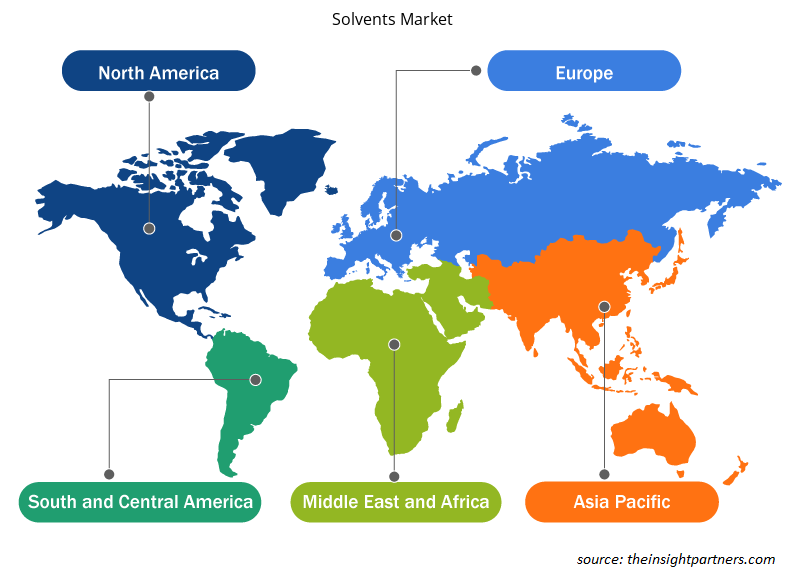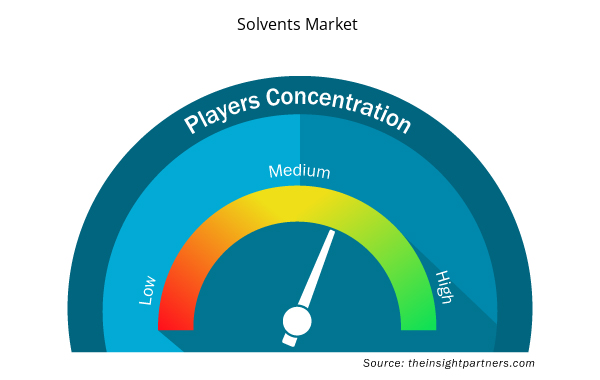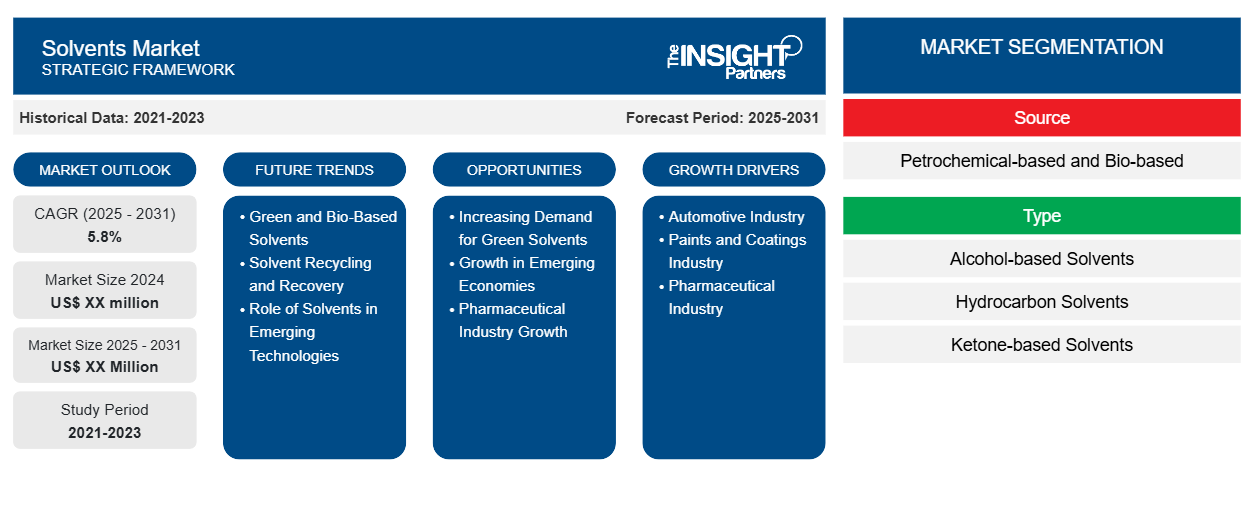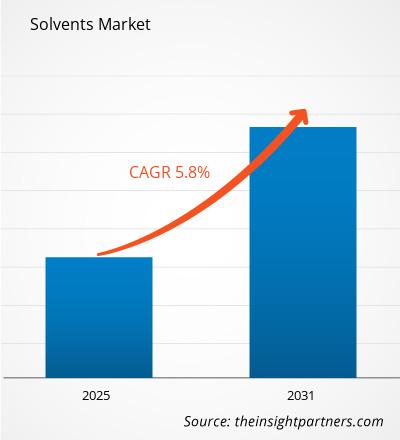Es wird erwartet, dass der Lösungsmittelmarkt von 2024 bis 2031 eine durchschnittliche jährliche Wachstumsrate (CAGR) von 5,8 % verzeichnet, wobei die Marktgröße von XX Millionen US-Dollar im Jahr 2024 auf XX Millionen US-Dollar im Jahr 2031 wächst.
Der Bericht ist nach Quelle (petrochemisch und biobasiert) segmentiert. Der Bericht enthält außerdem eine Analyse basierend auf dem Typ (Lösungsmittel auf Alkoholbasis, Kohlenwasserstofflösungsmittel, Lösungsmittel auf Ketonbasis, Ester, chlorierte Lösungsmittel und andere). Der Bericht ist außerdem nach Anwendung segmentiert (Farben und Beschichtungen, Pharmazeutika, Agrochemikalien, Klebstoffe, Körperpflege und Kosmetik, Chemikalien, Gummi und andere). Der Berichtsumfang umfasst fünf Regionen: Nordamerika, Europa, Asien-Pazifik, Naher Osten und Afrika sowie Süd- und Mittelamerika und wichtige Länder in jeder Region. Die globale Analyse ist weiter auf regionaler Ebene und nach wichtigen Ländern aufgeschlüsselt. Der Bericht bietet den Wert in USD für die oben genannte Analyse und Segmente.
Zweck des Berichts
Der Bericht „Lösungsmittelmarkt“ von The Insight Partners soll die aktuelle Situation und das zukünftige Wachstum sowie die wichtigsten treibenden Faktoren, Herausforderungen und Chancen beschreiben. Dies wird verschiedenen Geschäftspartnern Einblicke geben, wie zum Beispiel:
- Technologieanbieter/-hersteller: Um die sich entwickelnde Marktdynamik zu verstehen und die potenziellen Wachstumschancen zu kennen, damit sie fundierte strategische Entscheidungen treffen können.
- Investoren: Durchführung einer umfassenden Trendanalyse hinsichtlich der Marktwachstumsrate, der finanziellen Marktprognosen und der Chancen entlang der Wertschöpfungskette.
- Regulierungsbehörden: Zur Regulierung von Richtlinien und Überwachungsaktivitäten auf dem Markt mit dem Ziel, Missbrauch zu minimieren, das Vertrauen der Anleger zu bewahren und die Integrität und Stabilität des Marktes aufrechtzuerhalten.
Lösungsmittel Marktsegmentierung
Quelle
- Auf petrochemischer und biobasierter Basis
Typ
- Lösungsmittel auf Alkoholbasis
- Kohlenwasserstoff-Lösungsmittel
- Ketonbasierte Lösungsmittel
- Ester
- Chlorierte Lösungsmittel
Anwendung
- Farben und Lacke
- Pharmazeutika
- Agrochemikalien
- Klebstoffe
- Körperpflege und Kosmetik
- Chemikalien
- Beläge
Geographie
- Nordamerika
- Europa
- Asien-Pazifik
- Süd- und Mittelamerika
- Naher Osten und Afrika
Passen Sie diesen Bericht Ihren Anforderungen an
Sie erhalten kostenlos individuelle Anpassungen an jedem Bericht, einschließlich Teilen dieses Berichts oder einer Analyse auf Länderebene, eines Excel-Datenpakets sowie tolle Angebote und Rabatte für Start-ups und Universitäten.
- Holen Sie sich die wichtigsten Markttrends aus diesem Bericht.Dieses KOSTENLOSE Beispiel umfasst eine Datenanalyse von Markttrends bis hin zu Schätzungen und Prognosen.
Wachstumstreiber auf dem Lösungsmittelmarkt
- Automobilindustrie: Der Markt für Lösungsmittel wird im Allgemeinen stark von der chemischen Fertigungsindustrie beeinflusst. Lösungsmittel spielen in zahlreichen Anwendungen eine wichtige Rolle; sie tragen wesentlich zu allen industriellen Prozessen bei, die chemische Synthesen, Beschichtungen, Farben, Klebstoffe, Kunststoffe, Pharmazeutika und andere Körperpflegeprodukte betreffen. Mit der Expansion der Industrien, insbesondere in Entwicklungsländern, wird die Nachfrage nach Lösungsmitteln zur Formulierung von Chemikalien höchstwahrscheinlich steigen. Die Lösungsmittel erfordern Eigenschaftsanforderungen wie reduzierte Viskosität, Auflösung und Dispergierung, was ihre Nachfrage in vielen Branchen steigert.
- Farben- und Lackindustrie: Die beiden größten Branchen, die die größten Mengen an Lösungsmitteln verwenden, sind die Automobilindustrie sowie die Farben- und Lackindustrie. Die Autolacke, Grundierungen und Lackierungen verwenden Lösungsmittel, um Haltbarkeit, Farbkonsistenz und Widerstandsfähigkeit gegen Umwelteinflüsse zu erreichen. Die Nachfrage nach Hochleistungslacken und -farben, die mit der steigenden Automobilproduktion zunimmt, und der zunehmende Trend zur Autoreparaturlackierung befeuern diesen Markt ebenfalls. Auch bei der Fahrzeugindividualisierung, einem Trend nach vorne, macht die steigende Nachfrage nach umweltfreundlichen, hochwertigen Lacken den Lösungsmittelmarkt umso bedeutender. Sogar das Wachstum bei Bau- und Infrastrukturprojekten treibt die Nachfrage nach Farben und Lacken an, die die größten Verbraucher von Lösungsmitteln sind.
- Pharmaindustrie: Die Pharma- und Körperpflegeindustrie gehören zu den größten Verbrauchern von Lösungsmitteln, die bei der Formulierung von Medikamenten, Kosmetika und Körperpflegeprodukten verwendet werden. Die Nachfrage nach pharmazeutischen Produkten, darunter Impfstoffe, Salben und orale Medikamente, steigt mit der Alterung der Weltbevölkerung, und es werden hochreine Lösungsmittel benötigt. In der Körperpflege kommen Lösungsmittel in einer breiten Palette von Formulierungen vor, von Haut- und Haarpflege bis hin zu Parfüms und Make-up-Produkten. Abgesehen davon war die steigende Nachfrage nach sowohl pharmazeutischen als auch Körperpflegeprodukten, insbesondere in Schwellenländern, ein Katalysator für das Wachstum des Lösungsmittelmarktes.
Zukünftige Trends auf dem Lösungsmittelmarkt
- Grüne und biobasierte Lösungsmittel: Darüber hinaus haben das wachsende Interesse und die Regulierung von Umweltfragen und flüchtigen organischen Verbindungen den Trend zu grünen und biobasierten Lösungsmitteln vorangetrieben. Traditionell werden sie aus erneuerbaren Quellen hergestellt: Pflanzenölen, Mais oder Soja. Sie bieten daher eine neue Klasse von Lösungsmitteln, die weniger giftig sind und weniger flüchtige organische Verbindungen enthalten als herkömmliche Lösungsmittel auf petrochemischer Basis. Weitere Treiber sind die Nachfrage der Verbraucher nach grünen Produkten und der Druck durch Regulierungen zur Reduzierung der Umweltverschmutzung und Verbesserung der Sicherheit am Arbeitsplatz. Die wichtigsten Produktlinien, die diese grünen Lösungsmittel enthalten, sind Farben und Beschichtungen, Klebstoffe und Reinigungsmittel.
- Recycling und Rückgewinnung von Lösungsmitteln: Eine weitere Möglichkeit, den Nachhaltigkeitstrend auf dem Lösungsmittelmarkt zu unterstützen, ist der Rückgriff auf Recycling- und Rückgewinnungstechnologien für Lösungsmittel. Trends in diesem Bereich deuten darauf hin, dass die Automobil-, Chemie- sowie Farben- und Lackindustrie immer mehr auf frische Lösungsmittel angewiesen ist, indem sie Recyclingtechnologien einführen, die Lösungsmittel im Herstellungsprozess wiederverwenden können. Die Grundlage für eine solche Umstellung ist ökologischer Natur: das heißt, sie beruht auf der Abfallreduzierung und der Freisetzung schädlicher Emissionen in die Umwelt. Außerdem ist sie kostenbezogen: Sie spart Kosten für frische Lösungsmittel. Innovationen bei Lösungsmittelrückgewinnungssystemen sowie bei der Destillation steigern die Effizienz der Wiederverwendung von Lösungsmitteln. Unternehmen, die Abfall reduzieren und damit Geld bei der Produktion sparen möchten, finden Lösungsmittelrecycling praktikabel.
- Rolle von Lösungsmitteln in neuen Technologien: Lösungsmittel werden heute in zunehmendem Maße in fortschrittlichen und neuen Technologien eingesetzt, darunter in den Bereichen Elektronik, Batterien und erneuerbare Energien. Beispielsweise werden bei der Herstellung von Lithium-Ionen-Batterien für Elektrofahrzeuge Lösungsmittel eingesetzt, um Elektrolyte zu synthetisieren und das aktive Material zu dispergieren. Die zunehmende Verbreitung von Elektrofahrzeugen und anderen erneuerbaren Energiequellen wie Solarmodulen führt zu einer höheren Nachfrage nach Lösungsmitteln. Bei der Herstellung von Halbleitermaterialien, Photovoltaik und Dünnschichtelektronik spielen Lösungsmittel eine wichtige Rolle; diese Bereiche verzeichnen einen exponentiellen Aufschwung, vor allem aufgrund der technologischen Forschung und der Nachfrage nach weitaus energieeffizienteren Lösungen.
Marktchancen für Lösungsmittel
- Steigende Nachfrage nach umweltfreundlichen Lösungsmitteln: Der Markt für umweltfreundliche Lösungsmittel scheint viele Wachstumschancen zu haben, da in der Gesellschaft und in der Industrie bereits eine größere Nachfrage nach einer nachhaltigen Alternative als den herkömmlichen Lösungsmitteln auf Erdölbasis besteht. Eine wachsende Forderung nach umweltfreundlichen Praktiken in der Industrie motiviert den Einsatz umweltfreundlicher Lösungsmittel. Da Regierungen auf der ganzen Welt beginnen, die Emission flüchtiger organischer Verbindungen (VOC) durch strengere Vorschriften zu regulieren, wird die Nachfrage nach biobasierten und wenig toxischen Lösungsmitteln weiter steigen. Die Unternehmen, die biobasierte Lösungsmittel herstellen und verkaufen, werden von diesem Trend profitieren, indem sie umweltfreundliche Optionen in verschiedenen Endverbraucherbranchen wie Farben und Lacken, Klebstoffen, Reinigungsmitteln und Pharmazeutika anbieten.
- Wachstum in Schwellenländern: Der Lösungsmittelmarkt in Schwellenländern bietet erhebliche Wachstumschancen, insbesondere im asiatisch-pazifischen Raum, in Lateinamerika und Afrika, wo Industrialisierung und Urbanisierung voranschreiten. So wachsen beispielsweise die Chemie-, Automobil- und Fertigungsbranche, die den größten Lösungsmittelverbraucher darstellen, in Ländern wie China und Indien rasant. Da die Basis und Infrastruktur in den jeweiligen Regionen weiter ausgebaut werden, wird der Bedarf an Beschichtungen, Farben, Klebstoffen und Pharmazeutika sowie den entsprechenden Lösungsmitteln tendenziell steigen. Darüber hinaus werden die Sicherheits- und Umweltschutzbestimmungen mit der Reifung dieser Volkswirtschaften weiter verschärft; die Nachfrage nach hochentwickelten, wenig giftigen und umweltfreundlichen Lösungsmittelprodukten wird weiter steigen.
- Wachstum der Pharmaindustrie: Der Pharmamarkt, vor allem die Herstellung von injizierbaren Medikamenten, Impfstoffen und Biologika, stellt eine weitere wichtige Chance für Lösungsmittel dar. Pharmazeutische Formulierungen, die hochreine Lösungsmittel erfordern, umfassen Lösungsmittel in Arzneimittelverabreichungssystemen, Formulierungen und sterilen Produkten. Da sich die weltweite Gesundheitsversorgung verbessert, vor allem aufgrund chronischer Krankheiten und einer alternden Bevölkerung sowie des steigenden Bedarfs an komplexen Arzneimitteltherapien, wird auch der Bedarf an Speziallösungsmitteln in der Pharmaindustrie steigen. Unternehmen, die in der Lage sind, diese Nachfrage nach hochwertigen, sicheren und gesetzeskonformen Lösungsmitteln zu erfüllen, werden in diesem Bereich ein großes Marktpotenzial haben.
Regionale Einblicke in den Lösungsmittelmarkt
Die regionalen Trends und Faktoren, die den Lösungsmittelmarkt im Prognosezeitraum beeinflussen, wurden von den Analysten von Insight Partners ausführlich erläutert. In diesem Abschnitt werden auch die Marktsegmente und die geografische Lage des Lösungsmittelmarkts in Nordamerika, Europa, im asiatisch-pazifischen Raum, im Nahen Osten und Afrika sowie in Süd- und Mittelamerika erörtert.

- Holen Sie sich die regionalen Daten für den Lösungsmittelmarkt
Umfang des Marktberichts über Lösungsmittel
| Berichtsattribut | Details |
|---|---|
| Marktgröße im Jahr 2024 | XX Millionen US-Dollar |
| Marktgröße bis 2031 | XX Millionen US-Dollar |
| Globale CAGR (2025 - 2031) | 5,8 % |
| Historische Daten | 2021-2023 |
| Prognosezeitraum | 2025–2031 |
| Abgedeckte Segmente | Nach Quelle
|
| Abgedeckte Regionen und Länder | Nordamerika
|
| Marktführer und wichtige Unternehmensprofile |
|
Dichte der Akteure auf dem Lösungsmittelmarkt: Der Einfluss auf die Geschäftsdynamik
Der Markt für Lösungsmittel wächst rasant, angetrieben durch die steigende Nachfrage der Endverbraucher aufgrund von Faktoren wie sich entwickelnden Verbraucherpräferenzen, technologischen Fortschritten und einem größeren Bewusstsein für die Vorteile des Produkts. Mit steigender Nachfrage erweitern Unternehmen ihr Angebot, entwickeln Innovationen, um die Bedürfnisse der Verbraucher zu erfüllen, und nutzen neue Trends, was das Marktwachstum weiter ankurbelt.
Die Marktteilnehmerdichte bezieht sich auf die Verteilung der Firmen oder Unternehmen, die in einem bestimmten Markt oder einer bestimmten Branche tätig sind. Sie gibt an, wie viele Wettbewerber (Marktteilnehmer) in einem bestimmten Marktraum im Verhältnis zu seiner Größe oder seinem gesamten Marktwert präsent sind.
Die wichtigsten auf dem Lösungsmittelmarkt tätigen Unternehmen sind:
- BASF SE
- Exxon Mobil Corporation
- Dow Chemical
- Maruzen Petrochemical Co., Ltd.
- Shell Global
Haftungsausschluss : Die oben aufgeführten Unternehmen sind nicht in einer bestimmten Reihenfolge aufgeführt.

- Überblick über die wichtigsten Akteure auf dem Lösungsmittelmarkt
Wichtige Verkaufsargumente
- Umfassende Abdeckung: Der Bericht deckt die Analyse von Produkten, Dienstleistungen, Typen und Endbenutzern des Lösungsmittelmarktes umfassend ab und bietet einen ganzheitlichen Überblick.
- Expertenanalyse: Der Bericht basiert auf dem umfassenden Verständnis von Branchenexperten und Analysten.
- Aktuelle Informationen: Der Bericht stellt durch die Abdeckung aktueller Informationen und Datentrends Geschäftsrelevanz sicher.
- Anpassungsoptionen: Dieser Bericht kann angepasst werden, um spezifische Kundenanforderungen zu erfüllen und die Geschäftsstrategien optimal anzupassen.
Der Forschungsbericht zum Lösungsmittelmarkt kann daher dabei helfen, die Branchensituation und Wachstumsaussichten zu entschlüsseln und zu verstehen. Obwohl es einige berechtigte Bedenken geben kann, überwiegen die allgemeinen Vorteile dieses Berichts tendenziell die Nachteile.
- Historische Analyse (2 Jahre), Basisjahr, Prognose (7 Jahre) mit CAGR
- PEST- und SWOT-Analyse
- Marktgröße Wert/Volumen – Global, Regional, Land
- Branche und Wettbewerbsumfeld
- Excel-Datensatz



Report Coverage
Revenue forecast, Company Analysis, Industry landscape, Growth factors, and Trends

Segment Covered
This text is related
to segments covered.

Regional Scope
North America, Europe, Asia Pacific, Middle East & Africa, South & Central America

Country Scope
This text is related
to country scope.
Häufig gestellte Fragen
The technological advancements in solvent recycling and recovery are expected to be the key market trend.
The report can be delivered in PDF/Word format, we can also share excel data sheet based on request.
On the basis of geography, the solvents market is classified into North America, Europe, Asia Pacific, Middle East and Africa, and South and Central America
BASF SE, Exxon Mobil Corp, Dow Inc, Honeywell International Inc, Huntsman International LLC, Celanese Corp, Shell Plc, TotalEnergies SE, KH Chemicals BV, and Gulf Chemical and industrial Oils Co
The major factors driving the solvents market are:
1. Growth in the Chemical Manufacturing Industry.
2. Expansion of the Automotive and Paints & Coatings Sectors.
The Solvents Market is estimated to witness a CAGR of 5.8% from 2023 to 2031
Trends and growth analysis reports related to Chemicals and Materials : READ MORE..
The List Of Companies
- BASF SE
- Exxon Mobil Corporation
- Dow Chemical
- Maruzen Petrochemical Co. ,Ltd.
- Shell Global
- Celanese Corporation
- Solvay S. A.
- INEOS
- Honeywell International Inc.
- Huntsman Corporation
The Insight Partners performs research in 4 major stages: Data Collection & Secondary Research, Primary Research, Data Analysis and Data Triangulation & Final Review.
- Data Collection and Secondary Research:
As a market research and consulting firm operating from a decade, we have published and advised several client across the globe. First step for any study will start with an assessment of currently available data and insights from existing reports. Further, historical and current market information is collected from Investor Presentations, Annual Reports, SEC Filings, etc., and other information related to company’s performance and market positioning are gathered from Paid Databases (Factiva, Hoovers, and Reuters) and various other publications available in public domain.
Several associations trade associates, technical forums, institutes, societies and organization are accessed to gain technical as well as market related insights through their publications such as research papers, blogs and press releases related to the studies are referred to get cues about the market. Further, white papers, journals, magazines, and other news articles published in last 3 years are scrutinized and analyzed to understand the current market trends.
- Primary Research:
The primarily interview analysis comprise of data obtained from industry participants interview and answers to survey questions gathered by in-house primary team.
For primary research, interviews are conducted with industry experts/CEOs/Marketing Managers/VPs/Subject Matter Experts from both demand and supply side to get a 360-degree view of the market. The primary team conducts several interviews based on the complexity of the markets to understand the various market trends and dynamics which makes research more credible and precise.
A typical research interview fulfils the following functions:
- Provides first-hand information on the market size, market trends, growth trends, competitive landscape, and outlook
- Validates and strengthens in-house secondary research findings
- Develops the analysis team’s expertise and market understanding
Primary research involves email interactions and telephone interviews for each market, category, segment, and sub-segment across geographies. The participants who typically take part in such a process include, but are not limited to:
- Industry participants: VPs, business development managers, market intelligence managers and national sales managers
- Outside experts: Valuation experts, research analysts and key opinion leaders specializing in the electronics and semiconductor industry.
Below is the breakup of our primary respondents by company, designation, and region:

Once we receive the confirmation from primary research sources or primary respondents, we finalize the base year market estimation and forecast the data as per the macroeconomic and microeconomic factors assessed during data collection.
- Data Analysis:
Once data is validated through both secondary as well as primary respondents, we finalize the market estimations by hypothesis formulation and factor analysis at regional and country level.
- Macro-Economic Factor Analysis:
We analyse macroeconomic indicators such the gross domestic product (GDP), increase in the demand for goods and services across industries, technological advancement, regional economic growth, governmental policies, the influence of COVID-19, PEST analysis, and other aspects. This analysis aids in setting benchmarks for various nations/regions and approximating market splits. Additionally, the general trend of the aforementioned components aid in determining the market's development possibilities.
- Country Level Data:
Various factors that are especially aligned to the country are taken into account to determine the market size for a certain area and country, including the presence of vendors, such as headquarters and offices, the country's GDP, demand patterns, and industry growth. To comprehend the market dynamics for the nation, a number of growth variables, inhibitors, application areas, and current market trends are researched. The aforementioned elements aid in determining the country's overall market's growth potential.
- Company Profile:
The “Table of Contents” is formulated by listing and analyzing more than 25 - 30 companies operating in the market ecosystem across geographies. However, we profile only 10 companies as a standard practice in our syndicate reports. These 10 companies comprise leading, emerging, and regional players. Nonetheless, our analysis is not restricted to the 10 listed companies, we also analyze other companies present in the market to develop a holistic view and understand the prevailing trends. The “Company Profiles” section in the report covers key facts, business description, products & services, financial information, SWOT analysis, and key developments. The financial information presented is extracted from the annual reports and official documents of the publicly listed companies. Upon collecting the information for the sections of respective companies, we verify them via various primary sources and then compile the data in respective company profiles. The company level information helps us in deriving the base number as well as in forecasting the market size.
- Developing Base Number:
Aggregation of sales statistics (2020-2022) and macro-economic factor, and other secondary and primary research insights are utilized to arrive at base number and related market shares for 2022. The data gaps are identified in this step and relevant market data is analyzed, collected from paid primary interviews or databases. On finalizing the base year market size, forecasts are developed on the basis of macro-economic, industry and market growth factors and company level analysis.
- Data Triangulation and Final Review:
The market findings and base year market size calculations are validated from supply as well as demand side. Demand side validations are based on macro-economic factor analysis and benchmarks for respective regions and countries. In case of supply side validations, revenues of major companies are estimated (in case not available) based on industry benchmark, approximate number of employees, product portfolio, and primary interviews revenues are gathered. Further revenue from target product/service segment is assessed to avoid overshooting of market statistics. In case of heavy deviations between supply and demand side values, all thes steps are repeated to achieve synchronization.
We follow an iterative model, wherein we share our research findings with Subject Matter Experts (SME’s) and Key Opinion Leaders (KOLs) until consensus view of the market is not formulated – this model negates any drastic deviation in the opinions of experts. Only validated and universally acceptable research findings are quoted in our reports.
We have important check points that we use to validate our research findings – which we call – data triangulation, where we validate the information, we generate from secondary sources with primary interviews and then we re-validate with our internal data bases and Subject matter experts. This comprehensive model enables us to deliver high quality, reliable data in shortest possible time.


 Holen Sie sich ein kostenloses Muster für diesen Bericht
Holen Sie sich ein kostenloses Muster für diesen Bericht